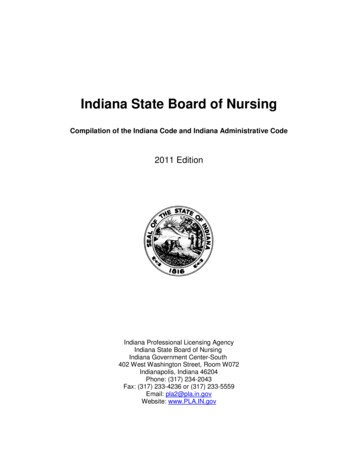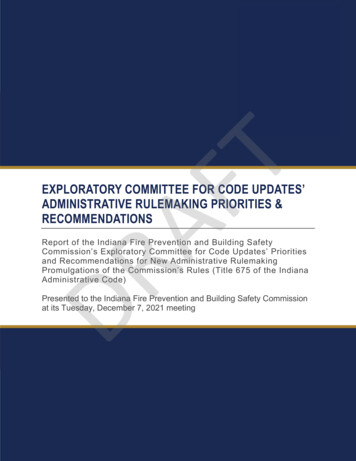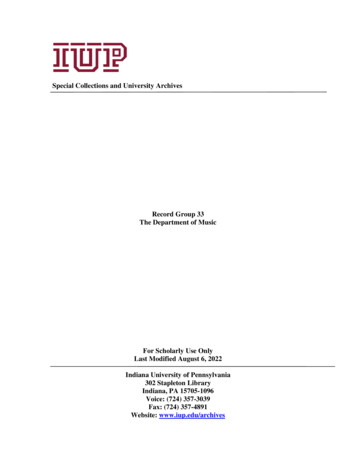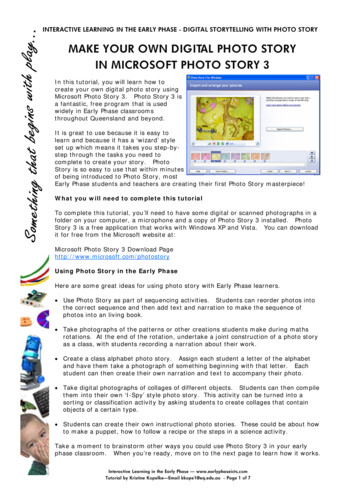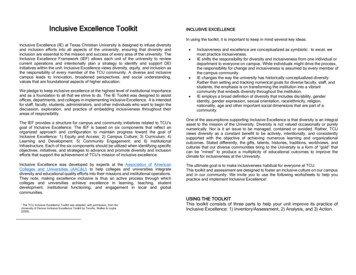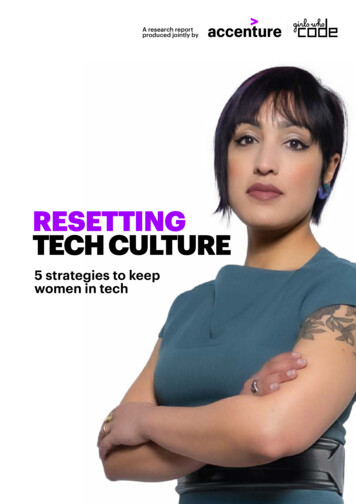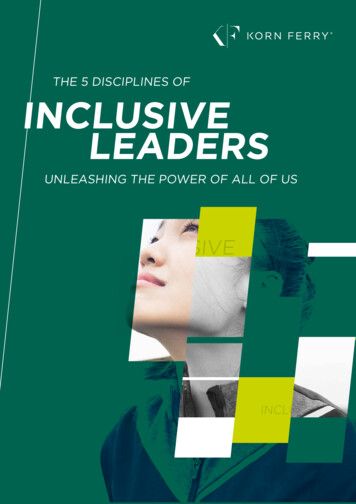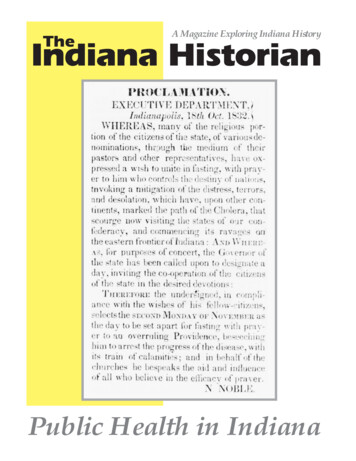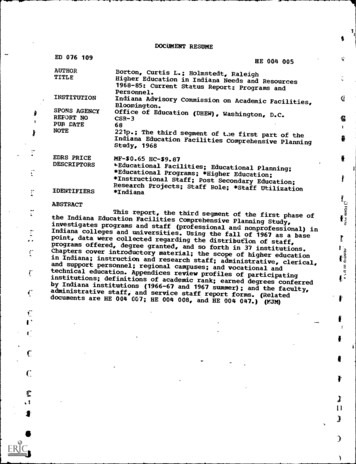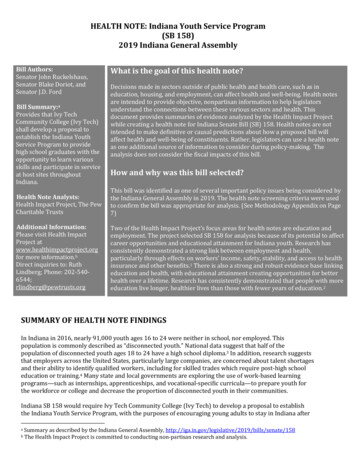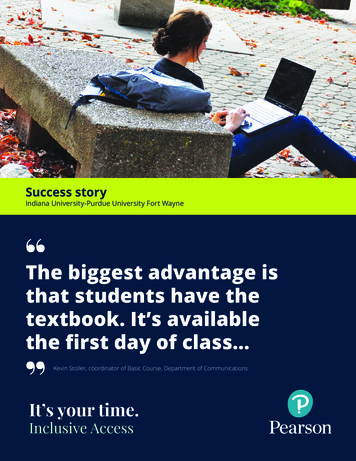
Transcription
Success storyIndiana University-Purdue University Fort WayneThe biggest advantage isthat students have thetextbook. It’s availablethe first day of class.Kevin Stoller, coordinator of Basic Course, Department of CommunicationsIt’s your time.Inclusive Access
OverviewA confluence of events prompted the Indiana University-PurdueUniversity Fort Wayne (IPFW), the fifth largest university in Indiana,Profile:Indiana University-PurdueUniversity Fort Wayneto consider using a digital delivery model for course materials in2011: mobile device usage on campus was growing, the collegeCity/Statebookstore was researching industry trends in the digital deliveryFort Wayne, Indianaof course materials, and faculty concern over students not havingaccess to course materials at the beginning of the term wasincreasing. IPFW formed a task force to study the situation andInstitution TypePublic 4-year universityimplemented an etextbook pilot program during the summer ofInstitution Enrollment2012. Based on feedback from the pilot program, the university13,459 studentsdesigned and implemented a digital delivery program with the goalsof increasing the accessibility and affordability of course materialsfor students.ChallengeIn the fall of 2012, IPFW surveyed students and faculty aboutrequired course materials. Thirty-six percent of students surveyedreported that they had not purchased the required course materialsEthnicity82% Caucasian5% African American5% Hispanic4% Other3% Asian1% American Indian/Alaskan Nativeat least once and forty-two percent waited one or more weeksafter the start of a class to purchase the required materials, thusconfirming faculty observations that students were not prepared tostart learning on the first day of class. Almost 90 percent of facultysurveyed strongly agreed or agreed that students who obtain therequired course materials performed better in class.The survey confirmed that some students could not afford coursematerials. A third of the students who responded that they hadnot purchased the required materials at least once did so due tothe cost. In addition, 15 percent of the total number of studentssurveyed responded that they had skipped or deferred taking aclass because of the cost of course materials. Based on the surveydata, the time seemed right for IPFW to implement a digital deliveryprogram which guaranteed that all students in a course wouldhave access to the materials on the first day of class and gave theuniversity the opportunity to obtain volume discounts on coursematerials from its publishers.1
SolutionAlthough the pilot program focused specifically on etextbooks,IPFW decided to expand its digital delivery initiative to includeadaptive online learning tools at the request of the MathDepartment, which was just one department of many thatused Pearson’s MyLab & Mastering programs in conjunctionwith their textbooks. For this initiative, the university selectedFollett’s IncludED program as the delivery platform, whichcould be integrated with its third-party learning managementsystem. IPFW began analyzing its workflow process to determinehow to include the required digital course materials fees instudents’ tuition payments.“Leading up to the implementation, I convened a fairly lengthyplanning process that brought together parts of the institutionthat ordinarily would never talk to each other,” explainedDigital delivery hasfulfilled our goals:getting studentsinvolved in the course— ready to do workon day one — andkeeping the cost ofthe textbook andaccess code down.—Deana Alexander, ContinuingLecture & Pre-Calculus CommitteeMember Mathematical SciencesSamantha Birk, associate director for instructional technology.“One of the biggest examples of that is the bookstore actuallytalking to the Registrar’s Office and the Bursar’s Office. Whatwe wanted to do was architect the workflow that we could putin place that would parallel what faculty do with traditionalcourse materials and textbooks so that we weren’t necessarilyimplementing or presenting to them something that wascompletely new.”Under the new workflow process, when faculty memberssubmit requests for course materials to the bookstore, theyalso indicate if they want to participate in the digital deliveryprogram. That information is sent to the Registrar’s Office,which tags students registered for courses and sectionsparticipating in the digital delivery program. The Bursar’sOffice uses the tags to charge students the appropriate coursematerials fees.2
Solution (cont)At the start of the digital delivery initiative, stakeholders had some concerns. SinceIPFW does not require students to own a digital device, the university was concernedthat even though the average student has three devices, not every student couldafford one. Some faculty members and students also preferred printed materials,because they liked the experience of physically turning pages, wanted to keep booksfor future reference, or got headaches from reading on screens. To address theseconcerns, the university decided not to mandate the delivery method of coursematerials but to allow faculty to opt in to the digital program. It also provides low orno cost (depending on the publisher) printed versions of the books. Use of the printedversions varies by course, but IPFW believes the books fulfill a need and plans tocontinue offering this option in the future.ResultsIPFW’s faculty opt-in digital delivery program has grown to include 19 subject disciplinesand 216 sections in the fall of 2014 (see Figure 1). Participating faculty are pleasedwith the increased access. Kevin Stoller, coordinator of Basic Course, Department ofCommunications, explained, “The biggest advantage is that students have the textbook.It’s available the first day of class, and you don’t have students not buying the book. It isthere. And so you know that from day one.” Participating students are also happy with theprogram. In his fall course evaluations, 80 percent of Stoller’s students said they wouldrecommend continuing to use etextbooks.Number of sectionsFigure 1Number of sections participating in IncludED digital delivery program2502001501061005002162041471269Summer 2012(Pilot)Fall 2012Spring 2013Fall 2013Spring 2014Fall 20143
Results (cont)Figure 2“IFPW has also seen cost savings in course materials for studentsunder the new digital delivery model. The university did a costCost comparison ofanalysis across participating courses, comparing the cost ofPrinciples of Ecology andpurchasing a new textbook and access code for online learning toolsEvolution and Masteringto the cost of an etextbook plus the access code. For its BiologyBiology Access Code11700 course, which uses Pearson’s Principles of Ecology and Evolutiontextbook and MasteringBiology online learning program, studentsaccessing the textbook digitally saved 39 percent (see Figure 2).”“When asked about the success of the digital delivery initiative,Birk replied, “I think part of the success we’ve had is due to havingsomebody in the role that I play, which is facilitating the program.If there is an issue, I figure out who needs to talk to whom and howto get it resolved. I also convene a yearly debrief meeting whenwe get around the table and all the stakeholders talk about whatworks, what didn’t work, what do we need to change, what issuesare coming up, and things like that.” Transitioning to digital deliveryhas been a challenge, but IPFW has developed the support andtriage systems necessary to affect change and reap the benefits ofincreased access and affordability.”To see how digital delivery can help your institutionmeet its goals, visit pearson.com/inclusive-accessThe key toimplementing ourdigital deliveryprogram is havingopen lines ofcommunication.—Samantha Birk, Associate Directorfor Instructional TechnologyIt’s your time.Inclusive AccessCopyright 2018 Pearson Education, Inc. or its affiliate(s). All rights reserved. INSTR5637-8226-PK-0518
University Fort Wayne (IPFW), the fifth largest university in Indiana, to consider using a digital delivery model for course materials in 2011: mobile device usage on campus was growing, the college . analysis across participating courses, comparing the cost of purchasing a new textbook and access code for online learning tools to the cost of .
